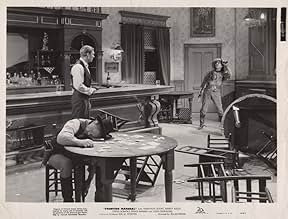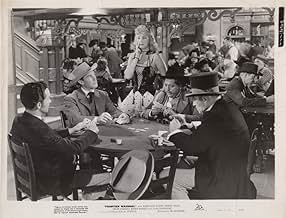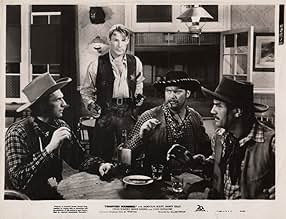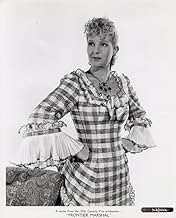NOTE IMDb
6,6/10
1,1 k
MA NOTE
Wyatt Earp accepte le poste de shérif afin de rétablir l'ordre à Tombstone.Wyatt Earp accepte le poste de shérif afin de rétablir l'ordre à Tombstone.Wyatt Earp accepte le poste de shérif afin de rétablir l'ordre à Tombstone.
- Réalisation
- Scénario
- Casting principal
- Récompenses
- 1 victoire au total
Dell Henderson
- Dave Hall
- (as Del Henderson)
Eddie Dunn
- Card Player
- (scènes coupées)
Avis à la une
What's most interesting about Frontier Marshal is the fact that it is clearly the genesis of My Darling Clementine, directed by John Ford seven years later. It is hard to view this movie without automatically thinking of the parallel scenes in MDC, and Ford's film draws heavily on the inter-relationships of Doc Holliday, Wyatt Earp, Sarah(Clementine in Ford's film) and the saloon girl, Jerry(Chihuahua). Other scenes are reworked into Ford's film as well
the disarming of the drunken Indian, dunking of the saloon girl into the trough, Doc Holliday attempting to redeem himself by performing surgery on a gunshot victim(in this case, the son of the Mexican bartender(in Ford's film, it was Chihuahua, Doc's `girl'), and a wandering theatric (a comic here, a Shakespearian thespian in MDC). This film is much slighter, with fewer themes and subtexts than Ford's and concentrates mostly on the relationship between Earp and Holliday and Holliday's redemption at the end. It plays out like a programmer, running a mere 71 minutes, so granted there isn't much time to devote to anything else. The themes of chaos versus order, civilization versus wilderness are only hinted at, and Randolph Scott is adequate as Wyatt Earp but without the underlying vulnerability(and humor) of Fonda's performance. The same might be said of Cesar Romero as Doc Holliday (for some reason changed to Halliday). He doesn't have the depth of Victor Mature's tortured Doc, in what was perhaps his best performance in any film, but the same self-destructive streak is evident as he attempts to drink himself to death, only to be stopped by Earp. Clearly, MDC was the more thought provoking of the two, but it cannot be denied that without Frontier Marshal, there would have been no MDC, or at least the one I consider a true western classic. What a quirk of fate that Ward Bond is in both films--the ineffective town marshal here, and later promoted to the role of Morgan Earp in Ford's version.
Randolph Scott, as Wyatt Earp, rides into Tombstone thinking about starting a stagecoach line. But Indian Charlie, drunk, starts shooting up the local saloon. The local marshal (Ward Bond) is afraid to go in and roust Charlie, so Earp dons a badge, goes in and drags him out by the feet. Earp becomes the full-time marshal. He meets Doc Halliday (Caesar Romero), a tubercular physician, gambler, and gunman, and after an initial wary brush, the two become more or less friends. Romero has a local trashy girlfriend (Binnie Barnes) whom Scott has to dump in a water trough. Doc gets liquored up, pulls his gun at the bar, and Earp knocks him out to save his life. An old flame of Doc's (Nancy Kelly) shows up in town, having pursued Doc all across the West, but Doc dumps her unceremoniously because he loathes what he's become. He redeems himself, however, by saving a badly wounded patient, only to be killed by Curly Bill and his gang as he walks out of the saloon door. There follows a shootout at the OK Corral in which Scott makes mincemeat of the bad guys. Binnie Barnes leaves town on the stage, and Kelly stays behind, probably not unaware of the moon eyes Scott has been casting her way.
Sound at all familiar? Seven years later it was remade as John Ford's "My Darling Clementine."
It isn't a bad movie, better than the majority of Westerns being made at the time. Yet one can't help wondering what makes Allan Dwan's "Frontier Marshal" an above-average Western and Ford's "My Darling Clementine" a classic.
Small things first. Dwan's movie is short on creativity in the wardrobe and makeup departments. Like most of the other principals, Scott dresses in an echt-1939 suit, only with a cowboy hat and gunbelt. The women's makeup dates badly, with dos out of the late 1930s and pencilled eyebrows and big lashes. It isn't that "Clementine" is extremely good in those respects -- it's just better.
The photography and location shooting don't reach the bar set by "Clementine" either. The photography isn't bad at all but it hardly fits into a Western frame. Almost the entire movie is shot at night, with no more than a handful of daylight scenes. The location isn't Monument Valley but it is, after all, Movie Flats which has been used expressively before. Here, it's not really present in any utilitarian sense because you can't SEE it at night.
Acting. Caesar Romero is probably as good as Victor Mature was in the later version. Binnie Barnes and Linda Darnell (in the same hooker role) are equally good, although they give us two quite different versions of what a hooker is like. Barnes is older, tougher looking, a bit treacherous. Darnell is younger, more Hispanic, tousle-haired, tempestuous, and childish. Scott is a competent actor, but Fonda is on the other hand outstanding. Throughout "Clementine" Fonda wears an expression that has something of puzzlement in it. When he whacks a guy over the head with the barrel of his pistol, he looks up from the unconscious body as if he's slightly surprised at what has happened and hasn't got a very clear idea of what's going to take place next.
Above all, there is the difference in direction. Dwan was a forthright story teller, a pioneer in the movies, and he does a good job. But Ford goes beyond the story, almost into visual poetry. "Clementine" has not only the family, but two opposing families, which gives the characters added depth and more intense motives. "Clementine" also has the familiar Ford opposition between the wilderness and the garden, which in Dwan's film is given very short shrift indeed. There is nothing in "Frontier Marshal" like the scene in which Fonda escorts Cathy Downs to the half-built church and awkwardly dances with her. What a celebration of community. Dwan's story deals with individuals who have conflicting ideas of how to get ahead. A couple of people know one another but there is little sense of a "town" in Dwan's movie. I won't go on about Ford's touches of roughhouse humor except to mention that they add another element lacking in "Frontier Marshal." There's an intentionality behind these brief incidents. Instance Fonda's dance with his feet against the porch post, or Darnell throwing a pitcher of milk in Ward Bond's face after he whinnies at her.
Still -- allright, so it's not a classic. But "Frontier Marshal" is better than most. And it's worth seeing for its historical value, a kind of lesson about how to make a good movie into a very good movie indeed.
Sound at all familiar? Seven years later it was remade as John Ford's "My Darling Clementine."
It isn't a bad movie, better than the majority of Westerns being made at the time. Yet one can't help wondering what makes Allan Dwan's "Frontier Marshal" an above-average Western and Ford's "My Darling Clementine" a classic.
Small things first. Dwan's movie is short on creativity in the wardrobe and makeup departments. Like most of the other principals, Scott dresses in an echt-1939 suit, only with a cowboy hat and gunbelt. The women's makeup dates badly, with dos out of the late 1930s and pencilled eyebrows and big lashes. It isn't that "Clementine" is extremely good in those respects -- it's just better.
The photography and location shooting don't reach the bar set by "Clementine" either. The photography isn't bad at all but it hardly fits into a Western frame. Almost the entire movie is shot at night, with no more than a handful of daylight scenes. The location isn't Monument Valley but it is, after all, Movie Flats which has been used expressively before. Here, it's not really present in any utilitarian sense because you can't SEE it at night.
Acting. Caesar Romero is probably as good as Victor Mature was in the later version. Binnie Barnes and Linda Darnell (in the same hooker role) are equally good, although they give us two quite different versions of what a hooker is like. Barnes is older, tougher looking, a bit treacherous. Darnell is younger, more Hispanic, tousle-haired, tempestuous, and childish. Scott is a competent actor, but Fonda is on the other hand outstanding. Throughout "Clementine" Fonda wears an expression that has something of puzzlement in it. When he whacks a guy over the head with the barrel of his pistol, he looks up from the unconscious body as if he's slightly surprised at what has happened and hasn't got a very clear idea of what's going to take place next.
Above all, there is the difference in direction. Dwan was a forthright story teller, a pioneer in the movies, and he does a good job. But Ford goes beyond the story, almost into visual poetry. "Clementine" has not only the family, but two opposing families, which gives the characters added depth and more intense motives. "Clementine" also has the familiar Ford opposition between the wilderness and the garden, which in Dwan's film is given very short shrift indeed. There is nothing in "Frontier Marshal" like the scene in which Fonda escorts Cathy Downs to the half-built church and awkwardly dances with her. What a celebration of community. Dwan's story deals with individuals who have conflicting ideas of how to get ahead. A couple of people know one another but there is little sense of a "town" in Dwan's movie. I won't go on about Ford's touches of roughhouse humor except to mention that they add another element lacking in "Frontier Marshal." There's an intentionality behind these brief incidents. Instance Fonda's dance with his feet against the porch post, or Darnell throwing a pitcher of milk in Ward Bond's face after he whinnies at her.
Still -- allright, so it's not a classic. But "Frontier Marshal" is better than most. And it's worth seeing for its historical value, a kind of lesson about how to make a good movie into a very good movie indeed.
For seventy-one minutes the film manages to fit in the deteriorating security situation in Tombstone as the camera flashes to the street for all the shootouts and horseplay. Compared to My Darling Clementine, this one is more easy going. Cesar Romero captures best acting over Vic Mature in the role of Doc Holliday, IMHO if only because Mature's part seemed overwrought, and the part of Holliday seems to fit Romero in a decisively more real way. Even still, the script in Frontier Marshal still caricatures Holliday as overly emotional, especially in the scenes in the saloon where he's purposely drinking himself to death because ex-flame Nancy Kelly comes in on the stage. Still, Romero was a great actor, and his scenes with Randolph Scott as Earp are a nice mix of two actors who had real naturalness. The B&W photography (Charles Clarke) stands out throughout and all the scenes in this movie are well assembled. It is over before you know it.
That would describe Wyatt Earp. Lucky because I can't think of anyone else who's had more stalwart Hollywood heroes playing him in film. Off the top of my head Tom Mix, George O'Brien, Henry Fonda, Burt Lancaster, James Garner, James Stewart, Joel McCrea right down to Kurt Russell and Kevin Costner. We certainly can't forget Hugh O'Brian on television. And also Wyatt was lucky in that he lived long enough so that no one was around to refute him when he gave a series of interviews to Stuart Lake for an authorized biography shortly before he died in 1929.
As this film is based on Lake's book you won't get anything else but the Wyatt of legend. Certainly Randolph Scott fulfills the legend and that's what we print according to John Ford.
This film isn't too often seen because whole parts of it were taken and used by John Ford in My Darling Clementine. Frontier Marshal should be seen back to back to graphically illustrate the difference between a good routine action western and an almost poetical film expression.
Parts that were played by Victor Mature, Cathy Downs, and Linda Darnell in My Darling Clementine are taken here by Cesar Romero, Nancy Kelly, and Binnie Barnes. It might seem odd that British Binnie Barnes would show up in a western as a saloon girl, but that's no more strange than Marlene Dietrich doing the same that year and being very accepted.
Eddie Foy, Jr. is in the cast playing his celebrated father who was entertaining in Tombstone at the time the Earps were providing law and order.
The Clantons believe it or not are completely eliminated from the story. The chief villain is real life Clanton retainer Curly Bill Brocius played here by Joe Sawyer. Eliminated also are Wyatt's brothers and as you can imagine the final shootout at the OK Corral is staged differently than in any other telling of the tale.
Probably Randolph Scott's Wyatt Earp would be a lot better known had he the benefit of John Ford's direction.
As this film is based on Lake's book you won't get anything else but the Wyatt of legend. Certainly Randolph Scott fulfills the legend and that's what we print according to John Ford.
This film isn't too often seen because whole parts of it were taken and used by John Ford in My Darling Clementine. Frontier Marshal should be seen back to back to graphically illustrate the difference between a good routine action western and an almost poetical film expression.
Parts that were played by Victor Mature, Cathy Downs, and Linda Darnell in My Darling Clementine are taken here by Cesar Romero, Nancy Kelly, and Binnie Barnes. It might seem odd that British Binnie Barnes would show up in a western as a saloon girl, but that's no more strange than Marlene Dietrich doing the same that year and being very accepted.
Eddie Foy, Jr. is in the cast playing his celebrated father who was entertaining in Tombstone at the time the Earps were providing law and order.
The Clantons believe it or not are completely eliminated from the story. The chief villain is real life Clanton retainer Curly Bill Brocius played here by Joe Sawyer. Eliminated also are Wyatt's brothers and as you can imagine the final shootout at the OK Corral is staged differently than in any other telling of the tale.
Probably Randolph Scott's Wyatt Earp would be a lot better known had he the benefit of John Ford's direction.
Early version of the Earp-Holliday, OK Corral legend.
Thanks to big-budget TCF, this is a well-produced, mid-level Western. Those barroom scenes along with the crowded streets are high energy and appropriate to a boomtown, which Tombstone was. Dwan directs these scenes with flair. Can't say the same for the final shootout that is poorly staged and fleetingly done as if the production had to hurry up to meet schedule. Ford's 1946 remake My Darling Clementine greatly improves on that final showdown with the kind of close-ups and structured tension that're needed.
Scott and Romero cut formidable figures as the legendary heroes. The screenplay suffers, however, by failing to spotlight an equally formidable villain to challenge them, spreading the villainy instead across several minor players. Too bad the impressive Carradine is largely wasted in an incidental role. On the other hand, Kelly is very pretty as the good girl, while Barnes shines as the good-time girl. I like the way their rivalry evolves over time.
I can see why the estimable John Ford saw so much potential in the characters and story. There's a lot of color in the array of personalities and rivalries, including the show biz Eddie Foy Jr., an entertaining contrast to the frontier types. Of course, Ford's version is clearly superior. Still, this 1939 entry remains a respectable little Western with its own modest merits.
Thanks to big-budget TCF, this is a well-produced, mid-level Western. Those barroom scenes along with the crowded streets are high energy and appropriate to a boomtown, which Tombstone was. Dwan directs these scenes with flair. Can't say the same for the final shootout that is poorly staged and fleetingly done as if the production had to hurry up to meet schedule. Ford's 1946 remake My Darling Clementine greatly improves on that final showdown with the kind of close-ups and structured tension that're needed.
Scott and Romero cut formidable figures as the legendary heroes. The screenplay suffers, however, by failing to spotlight an equally formidable villain to challenge them, spreading the villainy instead across several minor players. Too bad the impressive Carradine is largely wasted in an incidental role. On the other hand, Kelly is very pretty as the good girl, while Barnes shines as the good-time girl. I like the way their rivalry evolves over time.
I can see why the estimable John Ford saw so much potential in the characters and story. There's a lot of color in the array of personalities and rivalries, including the show biz Eddie Foy Jr., an entertaining contrast to the frontier types. Of course, Ford's version is clearly superior. Still, this 1939 entry remains a respectable little Western with its own modest merits.
Le saviez-vous
- AnecdotesCharles Stevens, who plays a drunken Indian, repeats the role in director John Ford's remake, La poursuite infernale (1946). Stevens, who was half Mexican and half Apache, was the grandson of legendary Apache warrior Geronimo.
- GaffesThe film has Doc Holliday being shot to death in an ambush by Curly Bill Brocius shortly before the shootout at the O.K. Corral in Tombstone, Arizona, on October 26. 1881. In reality, Holliday died of consumption in Glenwood Springs, Colorado, on November 8, 1887.
- Citations
Sarah Allen: John...
John 'Doc' Halliday: Yes, Sarah?
Sarah Allen: Isn't it more thrilling to give life than take it away?
- ConnexionsFeatured in Fejezetek a film történetéböl: Amerikai filmtípusok - A western (1989)
- Bandes originalesRock-a-Bye Baby
(1886) (uncredited)
Music and Lyrics by Effie I. Canning
Sung by Margaret Brayton a cappella
Meilleurs choix
Connectez-vous pour évaluer et suivre la liste de favoris afin de recevoir des recommandations personnalisées
- How long is Frontier Marshal?Alimenté par Alexa
Détails
- Durée1 heure 11 minutes
- Couleur
- Rapport de forme
- 1.37 : 1
Contribuer à cette page
Suggérer une modification ou ajouter du contenu manquant

Lacune principale
By what name was L'Aigle des frontières (1939) officially released in India in English?
Répondre


































